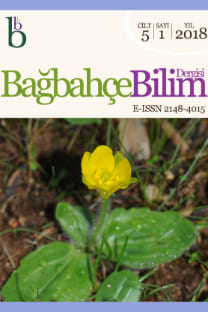Origanum L. (Ballıbabagiller / Lamiaceae) Cinsine Ait Yeni Bir Melez: Origanum × malatyanum Yıldız, Arabacı & Dirmenci
Bu çalışmada, Türkiye’den Origanum L. (Lamiaceae) cinsine ait yeni bir melez olan Origanum × malatyanum Yıldız, Arabacı & Dirmenci verildi. Yeni meleze ait örnekler Malatya ilinden toplandı. Yeni melez, ataları olan Origanum haussknectii Boiss. ve Origanum vulgare L. subsp. gracile (K.Koch) Ietsw. ile karşılaştırıldı. Melezin ayırt edici karakterleri, betimi, şekilleri ve dağılım haritası verildi. Ayrıca ata türler ile olan morfolojik farklılıkları tartışıldı. Yeni melezin gövde ve yaprak tüy durumu ve spiküllerin, bıraktelerin, çanak ve tacın şekli ve ölçüsü ile ebeveynlerinden farklılık gösterdiği belirlendi.
Leaf Micromorphogy of Cultivated Lettuce (Lactuca sativa L.) and its Wild Relatives
Cultivated lettuce (Lactuca sativa L.) is an economically important weedy plant for human consumption at worldwide. The primary gene pool of L. sativa consists of wild L. serriola L., L. aculeata Boiss. & Kotschy, L. azerbaijanica Rech. f., L. georgica Grossh. and L. scarioloides Boiss. while L. saligna L. is in its secondary gene pool. L. sativa has been subjected to various studies due to its economic importance. This study aims to reveal leaf micromorphology of the taxa in the primary and secondary gene pool of L. sativa and determinate these relationships based on leaf micromophological characters through phenetic analysis. In order to achieve these aims, character states of leaves belonging to the taxa were determined through multiple sampling and these data were subjected to analysis. According to the micromorphological data, L. saligna is the closest species to L. sativa and undulate anticlinal wall of epidermis cells is shared common character state for both taxa. The most variation was observed in density of epicuticular wax and wax type among the studied micromorphological characters. On the other hand the states of anticlinal and periclinal walls of epidermis cells are stable within the taxa. Indumentum on abaxial leaf surface is also stable within the taxa except L. saligna. In the light of these findings, anticlinal-periclinal walls of epidermis cells and indumentum can be used as distinctive characters to determine the boundaries between taxa in systematic studies in Lactuca.
Keywords:
Asteraceae, epidermis wall shape, lettuce gene pool, wax,
___
- Dirmenci, T., Kılıç, T., Çelenk, S., Martin, E., Arabacı, T., Yıldız, B. and Yazıcı, T. (2017). Türkiye'de Yetişen Origanum L. (Lamiaceae) Türleri Üzerinde Taksonomik, Moleküler, Karyolojik Ve Kimyasal Araştırmalar. TÜBİTAK-KBAG Projesi ( Proje no: 113 Z 225).
- Dirmenci, T., Yazıcı, T., Özcan, T., Çelenk, Ç. ve Martin, E. (2018). A new species and a new natural hybrid of Origanum L. (Lamiaceae) from the west of Turkey. Turk J Bot 42: 73-90.
- Dirmenci, T., Özcan, T., Yazıcı, T., Arabacı, T. ve Martin, E. (2018). Morphological, cytological, palynological and molecular evidence on two new hybrids: an example of homoploidhybridization in Origanum (Lamiaceae). Phytotaxa 371: 145-167.
- Dirmenci, T., Özcan, T., Açar, M., Arabacı, T., Yazıcı, T. ve Martin E. (2019). A rearranged homoploid hybrid species of Origanum L. (Lamiaceae): O. × munzurense Kit Tan & Sorger. Botany Letters 166: 153-162.
- Duman, H. (2000). Origanum L. Şu eserde: Güner, A., Özhatay, N., Ekim, T. ve Başer, K.H.C. (edlr.). Flora of Turkey and the East Aegean Islands (Suppl. 2), 11: 207-208. Edinburgh Univ. Press, Edinburgh.
- Ietswaart, J.H. (1980). A taxonomic revision of the genus Origanum (Labiatae). Leiden Botanical Series. No. 4: 21-24. Leiden Univ. Press, Netherlands.
- Ietswaart, J.H. (1982). Origanum L. Şu eserde: Davis, P. H., (ed.), Flora of Turkey and the East Aegean Islands, 7: 297–313. Edinburgh Univ. Press, Edinburgh.
- Menemen, Y. ve Dönmez, A.A. (2006) Uluslararası Botanik Adlandırma Yasası (Viyana Yasası). Onyedinci Uluslararası Botanik Kongresinde (Temmuz 2005, Viyana, Avusturya) kabul edilmiştir. (McNeill, J., Barrie, F.R., Burdet, H.M. vd.’den çeviri ). Türkçe baskı: Doğan Matbaacılık. Ankara.
- Yıldız, B., Bahçecioğlu Z. ve Arabacı T. (2004). Floristic Characteristics of Beydağı (Malatya). Turk J Bot 28: 391-419.
- ISSN: 2148-4015
- Yayın Aralığı: Yılda 3 Sayı
- Başlangıç: 2014
- Yayıncı: Ali Nihat Gökyiğit Eğitim ve Sağlık Kültür Sanat ve Doğal Varlıkları Koruma Vakfı
Sayıdaki Diğer Makaleler
Türkiye’deki Delimaydanoz / Oenanthe (Maydanozgiller / Apiaceae) Cinsinin Güncel Taksonomik Durumu
Ebru DOĞAN GÜNER, MEHTAP TEKŞEN, Barış BANİ
TURAN ARABACI, TUNCAY DİRMENCİ, Bayram YILDIZ
Inocybe grammatoides Esteve-Rav., Pancorbo & E.Rubio (Yahşikümbet)’in Avrupa Dışındaki İlk Kaydı
Turan ARABACİ, Tuncay DİRMENCİ, Bayram YILDIZ
Inocybe grammatoides Esteve-Rav., Pancorbo & E.Rubio (Yahşikümbet)’in Avrupa Dışındaki İlk Kaydı
MEHMET CENGİZ KARAİSMAİLOĞLU, Osman EROL
